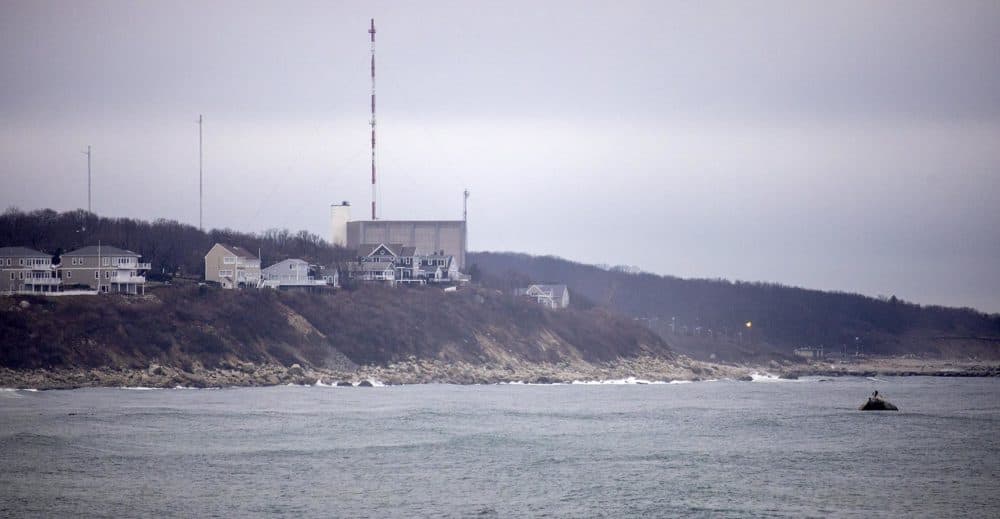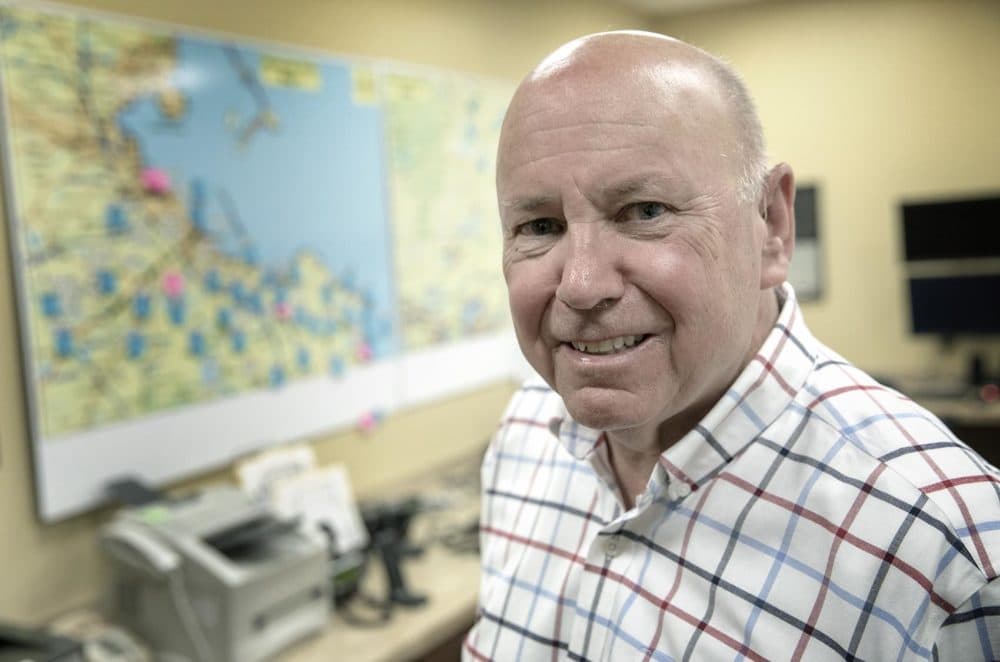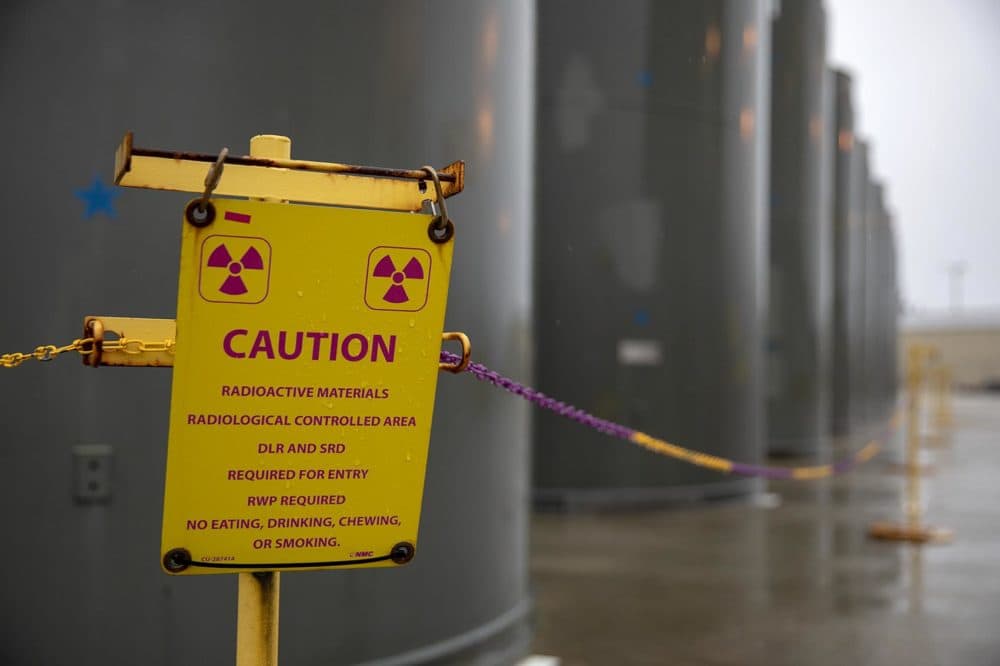Advertisement
Closing Pilgrim
Historic Plymouth Looks To A Future Without Pilgrim

Beneath a towering granite pavilion, in the smallest state park in Massachusetts, is an unassuming gray boulder with outsized historic and economic importance: Plymouth Rock.
The Rock draws a million visitors a year. Tourism is a powerful economic engine for Plymouth, employing 4,000 workers and generating $30 million annually in local taxes.
Five miles down the coast is Rocky Point, and the town's other giant economic engine: Pilgrim Nuclear Power Station. Pilgrim is the second-largest private employer in Plymouth. Its approximately 600 workers take home an average paycheck over $100,000 — double the typical wage in town. And the plant pays the highest property taxes in Plymouth.
In May, the nuclear plant is shutting down for good. And Plymouth — known as "America's Hometown" — will have to adjust to life post-Pilgrim.

Plymouth is one of just 60 communities in the United States with a nuclear power plant. Nuclear plants — even a relatively small one like Pilgrim — can have huge economic impacts, partly due to the large number of high-paid employees, according to Jonathan Cooper, research director at the Institute for Nuclear Host Communities.
Four years ago, as a University of Massachusetts Amherst graduate student, Cooper prepared a socioeconomic report anticipating the closing of Pilgrim. He found that the Pilgrim plant generates a quarter of a billion dollars in direct and indirect economic output for Plymouth and the surrounding region.
"The generic power plant shutdown is dealing with something very different from what a nuke is," Cooper says.
Pilgrim's nearly identical sister plant — Vermont Yankee — shut down five years ago. Plymouth officials met with their Vernon counterparts to learn from their experience.
Advertisement

"The power plant in Vermont has been an excellent example for the town of Plymouth," says Lee Hartmann, director of planning and development for Plymouth. "Some of the things we'd like to work here that they were able to do, and some of the things that haven't worked well — hopefully we can learn from them."
Entergy — owner of both plants — gave rural Vernon just 16 months notice to prepare for shutdown. Plymouth — whose population has grown from 18,000 in 1970 to more than 60,000 today — got more than three years advance notice.
"We've been engaged with the town for quite some time now," says Joe Lynch, Entergy's manager of government affairs. "There's going to be a step-down in the total number of employees, so the town can start making some plans for it."
Entergy will help the 600 Pilgrim nuclear workers who want to stay in the industry relocate out of state, and provide retraining for others. Many will retire.
But the effect will reach beyond jobs at the plant. For every Pilgrim employee, one job was created in the region, according to Cooper.
"Somebody at the plant estimated they spend $40,000 a year on pizza," says town planner Hartman. "For me that's a good example of what a plant like that generates in the community, in addition to taxes and good jobs."
Boli Matute's pizza shop is the closest to the power plant. He says a typical order is as many as 15 pizzas, and Pilgrim is a good customer.
"Now that they're going to close the plant — I don't know," he says. "It's going to be hard [for] everyone — not just us."

Aubuchon Hardware is near the road leading to Pilgrim. Assistant manager Al Carreiro also calls Pilgrim a good customer.
"They'd purchase a lot of ice melt, rock salt — six or seven tons a year — so I'm going to be losing that," he says.
The Nuclear Regulatory Commission had judged Pilgrim to be one of the least-safe nuclear plants in the nation, but in March it restored the safety status to normal.
"I think it was time for the plant to close," says Plymouth Town Manager Melissa Arrighi. Though "certainly there was concern about the loss of revenue."
Pilgrim generates just under 5% of Plymouth's property taxes, but that's still three times bigger than the town's next-largest corporate taxpayer. Plymouth and Entergy recently negotiated a two-year, $13.5 million deal to ease the transition to the plant's decommissioning. Holtec International, the company proposing to buy Pilgrim, has not yet negotiated a tax deal with the town.
"In terms of paying taxes on the land ... as long as that property is owned by — I don't care what the name of the company is — they will be paying taxes to Plymouth," Arrighi says. "If we're not able to secure or negotiate a payment in lieu of a tax agreement, we'll send them a bill like everyone else. And if they want to file for an abatement, that's certainly in their rights. We'll set the money aside and deal with it in the appellate tax court."
The buyer of Pilgrim will get the $1 billion decommissioning trust fund that's accumulated over the years, and 1,500 acres of valuable forest and shoreline surrounding the plant.
"We're very concerned whose hands it will end up in," Arrighi says. "The future of the property is the elephant in the room at every meeting we go to. The development of that could widely change the landscape and fabric of this community."

Another question: What happens to Plymouth's Emergency Ops Center, 10 miles south of the plant.
Entergy has been paying the town and state nearly $3 million a year to support the center. That funding stops at the end of year, according to center director Henry Lipe. "At some point the town will have to have the debate at town meeting, to transition to emergency management and the town's operating budget."
When Pilgrim shuts down, it will still pose a potential danger. Thousands of spent fuel assemblies will be moved into huge storage casks on site, but will remain intensely radioactive for thousands of years.
"If there are spent fuel rods here in Plymouth, on our land, then whoever the owner is has to contribute to the emergency planning," says Town Manager Arrighi.

"Ultimately, we are a de facto nuclear fuel repository," says state Sen. Vinny deMacedo, who represents Plymouth. "I believe there needs to be compensation to a community that has to address the public safety needs that has a nuclear power plant."
DeMacedo's brother, Olly deMacedo, has another concern. He is executive director of Plymouth's "America's Hometown" Thanksgiving Parade. Entergy was a major donor.
"Entergy was always there for us," he says. "There were years Entergy gave us $30,000 — that was a major funding source. We'll miss it."
2021 is the 400th anniversary of the first Thanksgiving, commemorating when members of the Wampanoag tribe — who lived here for 10,000 years — shared what they had with the starving Pilgrims.
Now, as Plymouth celebrates its history, it looks to a future without the nuclear plant that powered so much of its economy.
Correction: An earlier version of this audio story misstated the number of years Pilgrim has been operating. We regret the error.
For more environmental coverage from WBUR, follow Earthwhile on Twitter and Facebook.
This article was originally published on April 24, 2019.
This segment aired on April 24, 2019.
